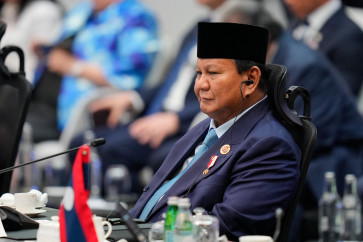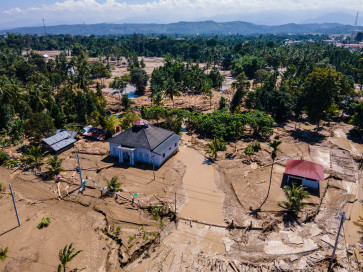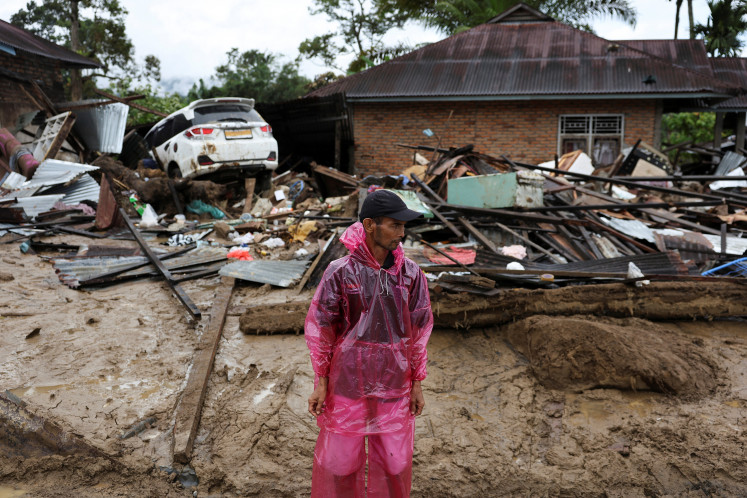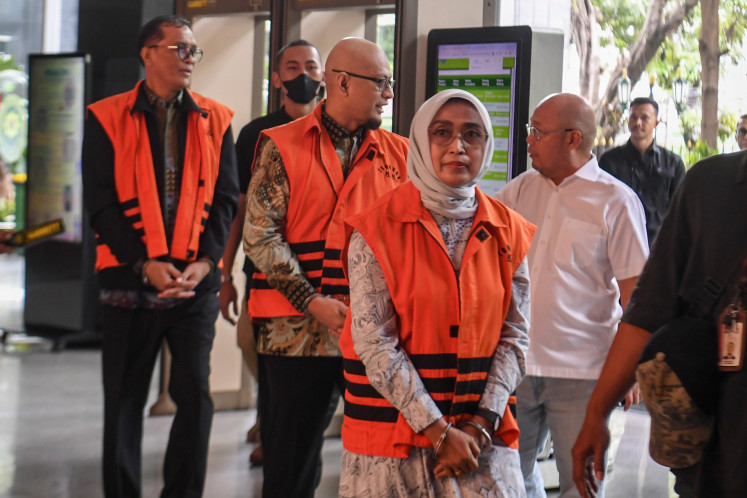Popular Reads
Top Results
Can't find what you're looking for?
View all search resultsPopular Reads
Top Results
Can't find what you're looking for?
View all search resultsThe untold story of the Surabaya battle of 1945
The epic battle that took place in Surabaya on Nov
Change text size
Gift Premium Articles
to Anyone
T
he epic battle that took place in Surabaya on Nov. 10, 1945 was one of the most heroic and violent episodes of the Indonesian Independence War. The Allied Forces, led by the British Army, launched a massive attack, deploying the most-modern weaponry at their disposal, including 24,000 troops, 25 pounders and 3.7 howitzer artilleries, five Destroyer warships, 24 Sherman tanks and 24 Thunderbolts and Mosquito bombers to occupy the city.
It was reported that in the first day alone, the Allied Forces dropped about 500 bombs. It was only after three weeks that the Allies Forces could secure the city. As a consequence, the city was devastated while casualties were immense, taking of more than 40,000 lives, mostly civilians.
The Indonesian government declared Nov. 10 National Heroes Day to commemorate this event, with the hope that the new generation could emulate the spirit of those who sacrificed their lives for the love of their country.
For this reason, the government has promoted the story of the battle through the media, historical writings, movies and school curricula. However, this widely reproduced official version has been emphasizing the militaristic aspect of this event, putting the non-combat civilian aspects slightly aside. Thus, the historical reconstruction of the battle basically covers only one side of story while ignoring many other issues.
What were the real reasons behind the Allied Forces' decision to launch such a brutal and bloody assault on Surabaya? American historian William Frederick, in the Journal of Genocide Research, 14th edition 2012, revealed another motive behind the Allied Forces' attack.
From personal correspondence letters written by officers in charge of the attack, he found out another possible motive that links to the preceding events, apart from the killing of British Army officer
Brig. Gen. AWS Mallaby on Oct. 30, 1945.
The letters of Colonel LHO Pugh ' the deputy of General EC Mansergh the commanding officer in Indonesia ' to his wife, for example, explicitly stated the Allied Forces' mission was to 'to punish the Indonesians [...] who had beheaded the British officer, brutally murdered Dutch civilians, including women and children ['¦]'
________________
Our national historiography of the period between 1945 and 1949 has been constructed a 'sacred period'.
According to Frederick, the last part of Mansergh's letter referred to the killing of hundreds Dutch and Eurasian civilians who had just been released from Japanese internment camps by Indonesian militia and youth groups in October 1945. In addition, many Chinese and other Indonesian minority groups such as the Ambonese and Timorese, who were suspected of being Dutch spies or stood on the Dutch side, were also victims of the mass killings.
The fact became uglier as Frederick ' using survivor's testimonies ' found out that the perpetrators were not only mobs consisting of members of independent fighters or criminals, but also members of prominent or even (deviant) military officers. Frederick concluded that unlike in other parts of urban Java, the killings in Surabaya were committed in a more systematic way, not only by uneducated villagers but also by educated youth.
If Frederick's analysis is right, then we have a new understanding of the Surabaya affair, which was apparently much complex than what we learned from school textbooks.
As a matter of fact, the killing of Dutch, Eurasian and Indonesian minority groups (Chinese, Ambonese, Timorese, etc.) civilians in Surabaya was the only dark chapter of the wave of violence against thousands of others that took place almost simultaneously in most of urban Java and Sumatra, from September 1945 until around early 1946.
This period has been recalled in Dutch historiography as bersiaptijd or 'get-ready period', which barely has a place in our national historiography, although the total lost was immense, about 25,000 Dutch and Eurasian, 10,000 Chinese and thousands of other Indonesian minority groups.
Should we wonder why there was a long silence in our history?
The fact is that our national historiography of the period between 1945 and 1949 has been constructed a 'sacred period', when all Indonesians struggled to defend their newly gained Independence and when the destiny of our nation-state was endangered of being subverted by returning colonialism. Under such understanding, a militaristic approach championed historical writing, while other non-combatant affairs or non-physical struggles were sidelined.
Historical reconstruction was framed under nationalistic sprit as an effort to mold the very notion of Indonesian nationalism. This can be seen vividly through a myriad historical writings during the period, which emphasized the role of prominent (military) figures or contribution of certain organizations (religion, ethnic groups) and regions to this historical metanarrative.
Any 'unnecessary' stories were deemed irrelevant and consequently had no merit to have a place in historical writings. Or worse, any deviant story during the period was considered as having tainted the very sacred notion of the Indonesian revolution.
The period of 1945-1949 was a violent one. Various forms of violence occurred involving almost all groups of society. The Bersiap killings were part of the omnipresent violence during this period, along with collateral violence in 'formal' military battle or military operations as well as internal violence among Indonesians.
Undoubtedly, Indonesians suffered biggest losses during the period as thousands of civilians died, families were disunited and displaced, properties and sources of income were gone.
But, under the current historiographical mainstream, these losses have been simply classified under the term of 'sacrifice' ' at the will of the people, without further explanation. Meanwhile, the losses of those considered 'Dutch subjects' were completely ignored. No humanitarian concern has entertained the losses of these people.
I have no intention to take side or scapegoat particular groups involved in the conflict of 1945-1949, but I simply want to remind everyone to critically understand the history of the Indonesian decolonization period.
As such, I maintain that the extant mainstream of historical writings about the period are basically political and need to be refreshed. In the case of the violence in 1965, new takes on that time have been produced and have made us realize that state-sponsored historical narratives have been very much in favor of 'the winner', particularly the military, who then took power.
By criticizing its most 'sacred history', Indonesia will grow, not only because it honors its heroes and heroines but also because it open-heartedly accepts the darkest episode of its history.
____________________
The writer is a lecturer for the history department, Gadjah Mada University, Yogyakarta, and is a visiting fellow at KITLV Leiden, the Netherlands.










